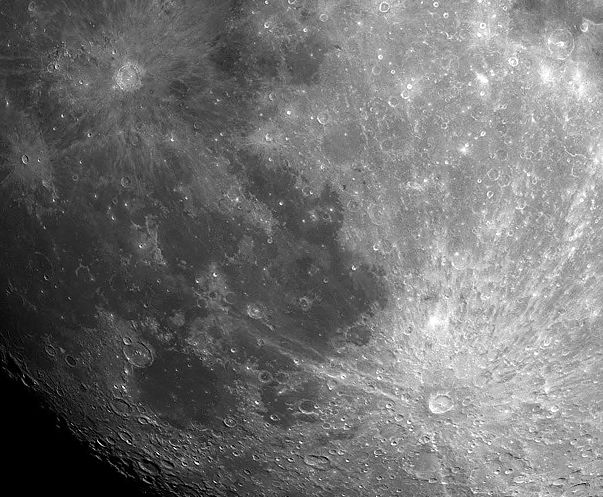Credit: Steve Mandel,
Hidden Valley Observatory
Explanation:
Dazzling in binoculars or a small telescope, the
Moon is
pocked with impact craters.
During partial
lunar
phases, the craters along the terminator
are cast in dramatic relief by strong shadows.
But when the
Moon is full some
craters seem to sprout systems
of bright radial lines or rays.
This detailed
digital close-up
of the full Moon features two
prominent ray craters,
Copernicus (upper left) and Tycho (lower right),
each with extensive ray systems formed of light colored debris blasted out
by the crater-forming impacts.
In general, ray
craters are relatively young as their rays overlay
the
lunar terrain.
In fact, at 85 kilometers wide, Tycho, with its far reaching rays,
is the youngest large
crater on the nearside.
Crater Copernicus,
surrounded by dark mare which contrast
nicely with its bright rays, is 93 kilometers in diameter.
1999 2000 2001 2002 2003 2004 2005 2006 2007 2008 2009 2010 2011 2012 2013 2014 2015 2016 2017 2018 2019 2020 2021 2022 2023 2024 2025 |
Январь Февраль Март Апрель Май Июнь Июль Август Сентябрь Октябрь Ноябрь Декабрь |
NASA Web Site Statements, Warnings, and Disclaimers
NASA Official: Jay Norris. Specific rights apply.
A service of: LHEA at NASA / GSFC
& Michigan Tech. U.
|
Публикации с ключевыми словами:
кратер - Луна - ray crater - crater - Copernicus - Tycho crater - Moon
Публикации со словами: кратер - Луна - ray crater - crater - Copernicus - Tycho crater - Moon | |
См. также:
Все публикации на ту же тему >> | |
